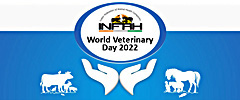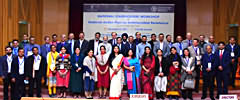Animal Husbandry in India
India has vast resources of livestock and poultry, which play a vital role in improving the socio-economic conditions of rural masses. There are about 303.76 million bovines, 74.26 million sheep, 148.88 million goats, 9.06 million pigs and about 851.81 million poultry as per 20th Livestock Census in the country.
| Species | 20th LS Census [2019] Millions |
Projected 2030 Millions & Gr % [2020-21] |
|---|---|---|
| Cattle | 193.46 | 196 [+1.2%] |
| Buffalo | 109.85 | 112 [+1.04%] |
| Sheep | 74.26 | 80 [+8%] |
| Goat | 148.88 | 160 [+8%] |
| Pig | 9.06 | 8 [-11%] |
| Total LS | 537 | 550 [+4%] |
| Poultry | 851.81 | 950 [12%] |
India continues to be the largest producer of milk in the world with 221.06 million tonnes produced during 2021-22, showing an annual growth of 5.29%. India contributes 23% to the global milk production. The per capita availability of milk is around 444 grams/day in 2021-22. Nearly 45% of the milk production is contributed by Indigenous/Non-Descript Buffaloes followed by 30% by crossbred cows. The Indigenous/Non-descript cows contribute 20% of the total milk production in the country. Goat milk shares a contribution of 3% in the total milk production across the country. The contribution of exotic cows in total milk production is 2%.
Poultry production in India has taken a quantum leap in the last four decades, emerging from conventional farming practices to commercial production systems with state-of-the-art technological interventions. India ranks 3rd in egg production with 129.60 billion numbers produced during 2021-22. The per capita availability during 2021-22 is around 95 eggs per annum. The egg production has shown growth as 6.19% during 2021-22.
Meat production during 2021-22 is 9.29 million tonnes. The Meat production has shown positive growth as 5.62% during 2021-22.
India is the 3rd largest fish producing country in the world and accounts for 7.96% of the global production. The total fish production during FY 22-23 is estimated at 16.25 Million Metric Tonnes (MMT) with a contribution of 12.12 MMT from the inland sector and 4.13 MMT from the marine sector. India ranks second in fish production in the world after China. Inland fish production constitutes about 75 percent of the total fish production of the country and annual growth rate of production has also been high. The fish production in the country has shown continuous and sustained increment since independence. During FY 2021-22, 77 percent of Marine Fisheries potential and 71 percent of the Inland Fisheries potential have been harnessed. Freshwater aquaculture with a share of 34 percent in Inland Fisheries in mid-1980 has increased to about 76 percent in recent years.
| Particulars | Rank | 2020-21 |
|---|---|---|
| Milk [Million Tons] | 1st | 1210 [2021-22] |
| Egg [Billion Nos.] | 3rd | 122.05 |
| Meat [Million Tons] | 6th | 8.8 |
| Fish [Million Metric Tons] | 3rd | 14.73 |
Contribution to Economy
Livestock is an important source of income for landless and marginal farmers and plays an important role in the national economy. Livestock Sector has continuously been growing at Compound Annual Growth Rate (CAGR) of 7.93% (at constant price) from 2014-15 to 2020-21, which is comparable to CAGR of manufacturing at 4.93% (at constant price) and Services at 4.82% (at constant price) and in contrast to Agriculture (Crop Sector) CAGR of 2.05% (at constant price) . Agriculture (crop sector) contributed 8.96 % (at constant prices) of total GVA, whereas livestock sector contributed 4.90% (at constant prices) of total GVA in 2020-21.
The Gross Value Added (GVA) of the livestock sector is about Rs. 11,14,249 crore at current prices during FY 2020-21 which is about 30.87% of Agricultural and Allied Sector GVA and 6.17% of Total GVA. At constant prices (2011-12), the GVA of the livestock sector is about Rs. 6,17,117 crore during FY 2020-21 with a positive growth of 6.13% over previous financial year.
Fisheries has emerged as a sunrise sector and has been an important sector that provides food, nutrition, employment, income and livelihood in India. Transformation of the fisheries sector from traditional to commercial scale has led to a significant contribution to India’s economy. The total Gross Value Added (GVA), at Constant prices, in 2022-2023 is estimated at Rs. 1,37,716 crore that constitutes about 1.09 percent of the total national GVA and 6.72 percent of agricultural GVA. The fisheries sector has been one of the major contributors of foreign exchange earnings, with India being one of the leading seafood exporting nations in the world. During FY 2021-22, export of marine products stood at 1.37 MMT and valued at Rs. 57,586.48 crore (USD: 7.76 billion) with an impressive average annual growth rate of about 10% in recent years.
The animal husbandry, dairying and fisheries sector plays a significant role in supplementing family incomes and generating employment in the rural sector. More than 20.5 million workers are engaged in animal farming and about 87.7% of the livestock is owned by farmers of marginal, small and semi-medium operational holdings. The animal husbandry and dairy sector provides around 50% direct & indirect employment to women in the country which is the highest for any sector in the economy. Around 5.51% of usually working persons are engaged in Animal Production, Mixed Farming, Fishing and Aquaculture during 2020-21. The fisheries sector provides livelihood to 16 million fishers and fish farmers at primary level.


